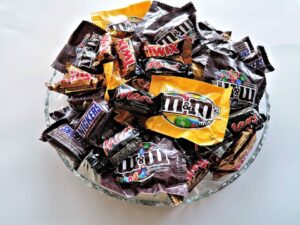This was first written by Katie Grubiak, RDN in 2015 and published on a national blog site. It has since been removed and is posted here with permission by Katie Grubiak, RDN, dietitian for people of all ages at Nutrition Illumination
Katie’s Six Tips To Make Halloween Fun–and Help Raise Intuitive Eaters
![Halloween, trick-or-treating, and intuitive eating 94568 | 91730 | 90631 | 94541 Halloween Candy and Intuitive Eating {Image description: a girl with a candy bag and wearing a costume with a pink dress is standing at the doorstep and an adult woman in costume is giving her candy] Represents a family in California who is practicing intuitive eating](https://www.eatingdisordertherapyla.com/wp-content/uploads/2023/10/halloween-1773447_1280-200x300.jpg)
Halloween is a favorite holiday for kids, but the focus on treats can stress out parents who worry about the health of their children. However, it doesn’t need to be a struggle. Dietitian Katie Grubiak, who works with clients of all ages (and practices from an Intuitive Eating approach), offers some tips to make this year’s Halloween fun and stress-free.
1. Don’t villainize candy: Don’t express worry or negativity about the candy or make comments about how unhealthy the treats are. Halloween is a great opportunity to send the message that there are no good foods or bad foods. People who develop eating disorders develop very black-and-white thinking and rigid dietary rules. By allowing candy and acting neutral toward it, you can set the tone that candy is both nothing to be afraid of and not that special. Research shows kids who are allowed candy are less likely to overeat it.
2. Don’t trick or treat on an empty stomach: Serve your child a balanced dinner (including all the major food groups) before sending them out to trick-or-treat. This will reduce the likelihood that they will overstuff themselves with candy.
3. Let your child celebrate the holiday: Participating in “life” is important. Holidays are a happy part of life; celebratory food and non-food fare should not be shamed out of the festivities. It is HEALTHY to celebrate, so let your child trick or treat and collect candy.

4. Use Halloween as an opportunity for your child to learn to self-regulate: When the child returns home don’t set a limit on how much they can eat. Allow the child to do the navigation. Instinctively they often dump the candy out and start categorizing what they want now or later or what they will give to their brother or sister because they don’t really want it anyway. They may also designate some to regift.
Over the next few days, allow the child to choose some Halloween candy at appropriate times, like desserts and snacks. This natural process is part of the excitement and fun. If you as a parent stay neutral, the candy fun will usually run its course over a few days and weeks. Trying to contain it can encourage hiding and lying about candy. Restriction often creates the desire to eat more. An “emotional charge” is put upon the candy: it ceases to be merely candy and becomes a token of shame. This fusion creates fertile ground for the cultivation of an eating disorder.
If you do not invest the candy with this power, it is likely that after a few days, the child will forget about the candy, at which time you can put it away or donate it.

5. Teach your child to listen to their own body signals on hunger and satiation: You can tell them you trust their body to tell them when they’ve had enough candy. If they do get a tummy ache, that is a learning opportunity!
6. It’s not just Halloween anymore: Other holidays and birthdays will arrive throughout the year. Encourage a similar process with all celebratory foods. Allow their natural presence and the desire they arouse to match the excitement around the occasion. Don’t stifle the natural flow. You will see that the sweets will have a special place in your child’s heart attached to the emotion of joy at the appropriate time and place. No dysfunction can come from that.
Halloween can be a wonderful opportunity to help children develop their intuitive eating skills!
Learn More About Raising Intuitive Eaters
To learn more about facilitating intuitive eating in children, we recommend the following book: How to Raise an Intuitive Eater: Raising the Next Generation with Food and Body by Sumner Brooks and Amee Severson. This book helps parents understand their own issues with food and body. It provides guidance about raising the next generation without these issues.
Learn How to Help Your Teen with an Eating Disorder Incorporate Halloween Candy
If you have a teen with an eating disorder, learn how to help them reintroduce candy.
About the Author
Katie Grubiak, RDN graduated from the Coordinated Program in Dietetics at The University of Texas at Austin. She first pursued a career in public health nutrition in San Diego and Los Angeles with a maternal-child focus. It was in the same underprivileged area of Los Angeles where she was serving nutritionally that she began to combine her passions, teaching dance and guiding families of dancers to public health clinic access at a foundation called everybody dance! which was awarded by First Lady Michelle Obama the National Arts & Humanities Youth Program Award.
Her involvement in multidisciplinary eating disorder treatment started at the UCLA Arthur Ashe Student Health & Wellness Center. Katie developed a unique style of practicing Family Based Treatment that was driven by her collaborations with Dr. Lauren Muhlheim at Eating Disorder Therapy LA. In addition, Katie was the eating disorder dietitian at Optimum Performance Institute in Woodland Hills, California. Katie now has her own nutrition and care coordination private practice named NUTRITION ILLUMINATION.